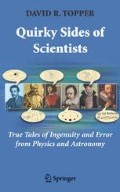Access this chapter
Tax calculation will be finalised at checkout
Purchases are for personal use only
Preview
Unable to display preview. Download preview PDF.
References
David Topper, “The Neutrino and the Sydney Opera House,” Leonardo 30, No. 2 (1997), pp. 81–83.
Kepler’s Mysterium Cosmographicum has been translated as The Secret of the Universe, by A.M. Duncan (New York: Abaris Books, 1981), material quoted from pp. 63–69, 105, and 157. I should point out that this is a translation of the second revised edition of 1621. See also, J.V. Field, Kepler’s Geometrical Cosmology (Chicago: University of Chicago Press, 1988), and Eric Aiton, “Johannes Kepler and the ‘Mysterium Cosmographicum,”’ Sudhoffs Archiv, vol. 61, No. 2 (1977), pp. 173–194.
The Harmonice Mundi by Kepler has been translated as The Harmony of the World, by E.J. Aiton, A.M. Duncan, and J.V. Field (Philadelphia: American Philosophical Society, 1997), material is quoted from pp. 406–407 and 424.
On the revival of ancients texts see Paul Lawrence Rose, “Renaissance Italian Methods of Drawing the Ellipse and Related Curves,” Physis, 12 (1970), pp. 371–404.
On Bode’s law see Michael Hoskin (ed.), The Cambridge Illustrated History of Astronomy (Cambridge: Cambridge University Press, 1997), pp. 186–193.
For a derivation of the equation for the empty focus, see my “Kepler’s Other ‘Law’ of Planetary Motion,” European Journal of Physics, 12 (1991), pp. 49–50. On Copernicus’s retention of the equant, see Noel M. Swerdlow, “An Essay on Thomas Kuhn’s First Scientific Revolution, The Copernican Revolution,” Proceedings of the American Philosophical Society, 148, No.1 (March, 2004), pp. 64–120, appendix 2 (pp. 111–115), and Otto Neugebauer, Astronomy and History: Selected Essays (New York: Springer-Verlag, 1983), pp. 92–96.
On Galileo’s father’s music theory, see Stillman Drake, Galileo Studies (Ann Arbor: University of Michigan Press, 1970), Chapter 2 (“Vincenzio Galilei and Galileo”). On the included plane experiment: “The Role of Music in Galileo’s Experiments,” Scientific American 232 (June, 1975), pp. 98–104.
Author information
Authors and Affiliations
Rights and permissions
Copyright information
© 2007 Springer Science+Business Media, LLC
About this chapter
Cite this chapter
Topper, D.R. (2007). The Data Fit the Model but the Model is Wrong: Kepler and the Structure of the Cosmos. In: Quirky Sides of Scientists. Springer, New York, NY. https://doi.org/10.1007/978-0-387-71019-8_6
Download citation
DOI: https://doi.org/10.1007/978-0-387-71019-8_6
Publisher Name: Springer, New York, NY
Print ISBN: 978-0-387-71018-1
Online ISBN: 978-0-387-71019-8
eBook Packages: Physics and AstronomyPhysics and Astronomy (R0)

